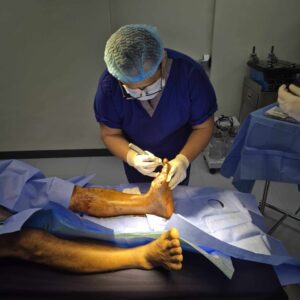Many women silently struggle with vaginismus, a condition that causes involuntary tightening of the pelvic floor muscles, making intimacy, tampon use, or medical exams painful or impossible. Beyond the physical challenges, the emotional toll can be overwhelming, leading to anxiety, frustration, and loss of confidence. Fortunately, vaginismus treatment through pelvic floor physical therapy offers a proven path toward both physical recovery and emotional empowerment. Osteopractic PT of Central Indiana stands out as the leading provider of this life-changing therapy, offering compassionate care and expert techniques to help women reclaim control of their bodies and their lives.
Understanding Vaginismus
Vaginismus is more than occasional discomfort—it’s a condition where the muscles around the vaginal opening contract involuntarily, creating a barrier to penetration. Symptoms may include burning, stinging, tightness, and heightened anxiety before intimacy or medical procedures. Causes can range from past trauma and fear of pain to underlying pelvic floor muscle dysfunction. Without effective vaginismus treatment, these symptoms can persist for years, impacting both physical health and relationships.
The Link Between Pelvic Floor Muscles and Vaginismus
The pelvic floor is a group of muscles that support the bladder, uterus, and rectum. When these muscles become overly tight or uncoordinated, they can trigger the pain and resistance associated with vaginismus. Successful vaginismus treatment focuses on retraining these muscles to relax and function normally, restoring comfort and confidence. By improving muscle awareness, control, and coordination, pelvic floor physical therapy directly addresses the root cause of the condition rather than just masking symptoms.
How Pelvic Floor Physical Therapy Works for Vaginismus
Osteopractic PT of Central Indiana uses a highly personalized approach to vaginismus treatment. The process typically begins with a gentle evaluation to understand your medical history, symptoms, and comfort level. From there, a tailored treatment plan may include:
- Manual Therapy – Hands-on techniques to release tension and improve muscle flexibility.
- Biofeedback Training – Using sensors to help you visualize and control pelvic floor activity.
- Gradual Desensitization – Step-by-step introduction of comfortable movement or dilators to reduce pain and fear.
- Breathing and Relaxation Exercises – Learning how to engage and release muscles in sync with calming techniques.
By combining these evidence-based methods, pelvic floor physical therapy helps break the pain cycle and rebuilds trust in your body.
Benefits of Pelvic Floor Physical Therapy for Vaginismus
When done consistently, vaginismus treatment through pelvic floor physical therapy offers both physical and emotional benefits:
- Significant reduction or elimination of pain during penetration
- Improved muscle control and relaxation ability
- Renewed confidence in intimate relationships
- Freedom from dependency on medication or invasive procedures
Patients at Osteopractic PT of Central Indiana often report feeling not just physically better, but emotionally lighter, with a renewed sense of hope for the future.
What to Expect During Your First Appointment
Your first visit for vaginismus treatment at Osteopractic PT of Central Indiana is designed to be comfortable and judgment-free. It begins with a detailed discussion about your symptoms, goals, and any previous attempts at treatment. If you feel ready, a gentle pelvic floor assessment may follow, but nothing happens without your consent. The therapist will then outline a clear, step-by-step plan so you know exactly what to expect in the weeks ahead.
Restoring Confidence Through Recovery
Physical healing is just one part of vaginismus treatment—emotional recovery is equally important. As pain decreases and comfort increases, many women find themselves reconnecting with their partners, rediscovering intimacy, and enjoying a greater quality of life. Osteopractic PT of Central Indiana is deeply committed to guiding you through both aspects of recovery, ensuring that your journey is as empowering as it is effective.
Tips for Maximizing Results
Your progress depends not just on clinic visits, but also on your commitment outside of sessions. Key ways to enhance your vaginismus treatment include:
- Following your prescribed home exercises consistently
- Keeping open communication with your partner for emotional support
- Practicing relaxation and mindfulness techniques daily
By staying engaged in the process, you help your body and mind adapt to positive change more quickly.
Finding the Right Pelvic Floor Physical Therapist
The success of your vaginismus treatment depends on choosing the right provider. Look for a therapist with specialized training in pelvic health, experience treating vaginismus, and a compassionate, patient-centered approach. Osteopractic PT of Central Indiana excels in all these areas, offering expert care in a safe and respectful environment where your comfort is the top priority.
Taking the First Step Toward Healing
Living with vaginismus can feel isolating, but you don’t have to face it alone. Pelvic floor physical therapy is a proven, effective vaginismus treatment that restores both physical function and emotional confidence. Osteopractic PT of Central Indiana has helped countless women take control of their health, rebuild intimacy, and embrace life without fear or pain. The first step is reaching out—and your path to recovery can begin today.
Frequently Asked Questions (FAQ)
Is pelvic floor physical therapy painful?
Treatment is designed to be gentle and comfortable. Your therapist will work at your pace, ensuring that you feel safe and in control.
How long does vaginismus treatment take?
Every case is unique, but many women see significant improvement within a few weeks to a few months, depending on the severity and consistency of care.
Can I try therapy if I’ve had vaginismus for years?
Yes. Pelvic floor physical therapy is effective even for long-standing cases, helping women at all stages of life.
Will my therapist also address emotional concerns?
While physical therapists focus on the body, they work closely with you to ensure emotional comfort, and may collaborate with counselors or other professionals if needed.
Can pelvic floor therapy help with other pelvic pain conditions?
Absolutely. Many women find relief from issues such as pelvic pain, bladder discomfort, or postpartum muscle dysfunction through pelvic floor physical therapy.











